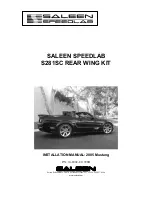
6-39
CAUTION: (Continued)
D Overinflated tires are more likely to be
cut, punctured or broken by a sudden
impact
--
such as when you hit a pothole.
Keep tires at the recommended pressure.
D Worn, old tires can cause accidents. If your
tread is badly worn, or if your tires have
been damaged, replace them.
See “Inflation
--
Tire Pressure” in this section
for inflation pressure adjustment for higher
speed driving.
Inflation -- Tire Pressure
The Tire
-
Loading Information label, which is located
on the rear edge of the driver’s door, shows the correct
inflation pressures for your tires when they’re cold.
“Cold” means your vehicle has been sitting for at least
three hours or driven no more than 1 mile (1.6 km).
If you’ll be driving at speeds higher than 100 mph
(160 km/h) where it is legal, raise the cold inflation
pressure of each tire to 38 psi (260 kPa) for tire size
P225/55R16 and to 39 psi (270 kPa) for tire size
235/45R17. When you end this very high
-
speed
driving, reduce the cold inflation pressures to those
listed on the Tire
-
Loading Information label.
NOTICE:
Don’t let anyone tell you that underinflation or
overinflation is all right. It’s not. If your tires
don’t have enough air (underinflation), you can
get the following:
D Too much flexing
D Too much heat
D Tire overloading
D Bad wear
D Bad handling
D Bad fuel economy.
If your tires have too much air (overinflation),
you can get the following:
D Unusual wear
D Bad handling
D Rough ride
D Needless damage from road hazards.
Содержание 2000 Catera
Страница 1: ......
Страница 127: ...2 62 The Instrument Panel Your Information System...
Страница 129: ...2 64 Instrument Panel Cluster United States Version Shown Canada Similar...
Страница 276: ...6 32 2 Remove the black rubber cap that protects the bulb area 3 Remove the plug connector from the bulb...
















































